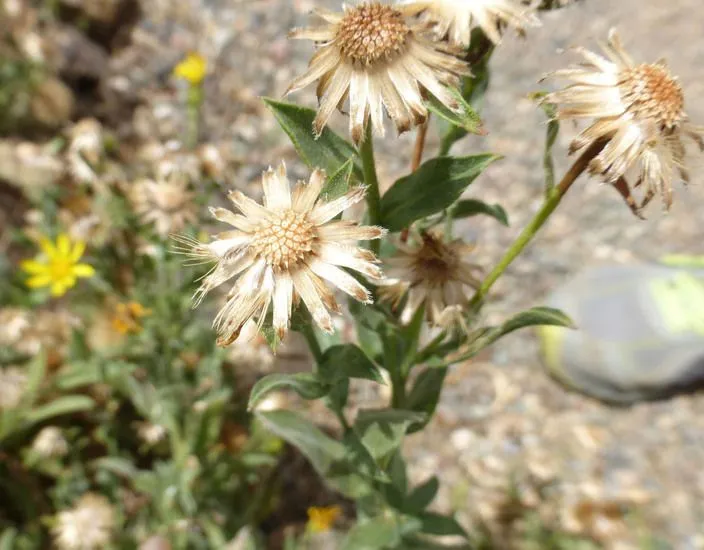
Author: (Pursh) Shinners
Bibliography: Field & Lab. 19: 71 (1951)
Year: 1951
Status: accepted
Rank: species
Genus: Heterotheca
Vegetable: False
Observations: C. Canada to WC. & C. U.S.A.
Hairy false golden-aster, or Heterotheca villosa, is a perennial herbaceous plant belonging to the Asteraceae family. Renowned for its hardy nature and vibrant yellow blossoms, this plant predominantly thrives across central Canada and stretches down through the west-central and central regions of the United States.
Characteristic of the Asteraceae family, Heterotheca villosa displays composite flowers. These blooms consist of bright yellow ray florets encircling a central cluster of disk florets. The overall appearance is reminiscent of a small sunflower, which is a common trait within its familial lineage. The ‘hairy’ denomination of its common name arises from the plant’s notably hirsute stems and leaves, which are covered in fine, soft hairs. This indumentum not only contributes to the plant’s distinguishing features but also serves as a protective adaptation against herbivory and desiccation in its native habitats.
In terms of habitat, Heterotheca villosa is quite versatile, populating diverse ecosystems ranging from prairies and grasslands to rocky slopes and roadsides. Its resilience to varying environmental conditions, including drought and poor soil quality, makes it an important species within its range for maintaining ecological balance. The plant’s extensive root system aids in soil stabilization, while its flowers provide nectar and pollen for various pollinators, including bees and butterflies.
Botanically first described under the nomenclature by Pursh and later re-classified by Shinners in the mid-20th century, as cited in Field & Lab. 19: 71 (1951), Heterotheca villosa holds both ecological value and botanical interest. It is frequently studied for its adaptive characteristics and its role within native plant communities. The species’ ability to thrive in varied and often harsh conditions underscores its importance from both a conservation and a horticultural perspective.
In summary, the Hairy false golden-aster is a robust and resilient native plant. It is fundamentally important for its ecological roles in North America’s central and western landscapes. The plant’s bright yellow flowers offer aesthetic beauty while supporting local wildlife, and its presence contributes to the health and stability of its natural habitats.
Eng: hairy goldenaster, hairy false goldenaster, prairie goldenaster
Fra: chrysopside velue, chrysopside villeuse
En: HAIRY FALSE GOLDEN-ASTER, Hairy false goldenaster, Hairy goldenaster, Prairie goldenaster
Fr: Chrysopside velue, Chrysopside villeuse
Taken May 26, 2022 by Chad Hammond (cc-by-sa)
Taken Aug 10, 2021 by Mark Henderson (cc-by-sa)
Taken Jul 13, 2018 by Sandy Rowley (cc-by-sa)
Taken Sep 5, 2020 by Cynthia Brinkley (cc-by-sa)
Taken Sep 11, 2020 by plants mustard (cc-by-sa)
Taken Jul 13, 2018 by Sandy Rowley (cc-by-sa)
Taken Aug 18, 2021 by Hill Paige (cc-by-sa)
Taken Sep 5, 2020 by Cynthia Brinkley (cc-by-sa)
Taken Dec 18, 2020 by Gatica Lucho (cc-by-sa)
Taken Aug 19, 2021 by Kimberly Reading (cc-by-sa)
Taken Nov 15, 2015 by EOL − Richard Spellenberg (cc-by-nc-sa)
Taken Aug 7, 2015 by EOL − Zoya Akulova (cc-by-nc)
Taken Oct 10, 2015 by EOL − Barry Breckling (cc-by-nc-sa)
Taken Aug 18, 2021 by Hill Paige (cc-by-sa)
Taken Jun 23, 2018 by Sandy Rowley (cc-by-sa)
Taken Aug 7, 2015 by EOL − Zoya Akulova (cc-by-nc)
Taken Sep 13, 2015 by EOL − Barry Breckling (cc-by-nc-sa)
Taken Sep 18, 2015 by EOL − Erica Krimmel (cc-by)
Taken Nov 12, 2012 by EOL − Richard Spellenberg (cc-by-nc-sa)
Taken Oct 12, 2015 by EOL − Barry Breckling (cc-by-nc-sa)
© copyright of the Board of Trustees of the Royal Botanic Gardens, Kew.
Growth form>: Multiple Stem
Growth habit>: Subshrub, Forb/herb
Growth rate>: Moderate
Ph maximum: 7.5
Ph minimum: 6.0
Family: Myrtaceae Author: (F.Muell.) K.D.Hill & L.A.S.Johnson Bibliography: Telopea 6: 402 (1995) Year: 1995 Status:…
Family: Rubiaceae Author: Pierre ex A.Froehner Bibliography: Notizbl. Bot. Gart. Berlin-Dahlem 1: 237 (1897) Year:…
Family: Sapindaceae Author: Koidz. Bibliography: J. Coll. Sci. Imp. Univ. Tokyo 32(1): 38 (1911) Year:…
Family: Asteraceae Author: A.Gray Bibliography: Pacif. Railr. Rep.: 107 (1857) Year: 1857 Status: accepted Rank:…
Family: Fabaceae Author: Medik. Bibliography: Vorles. Churpfälz. Phys.-Ökon. Ges. 2: 398 (1787) Year: 1787 Status:…
Family: Aspleniaceae Author: (Cav.) Alston Bibliography: Bull. Misc. Inform. Kew 1932: 309 (1932) Year: 1932…